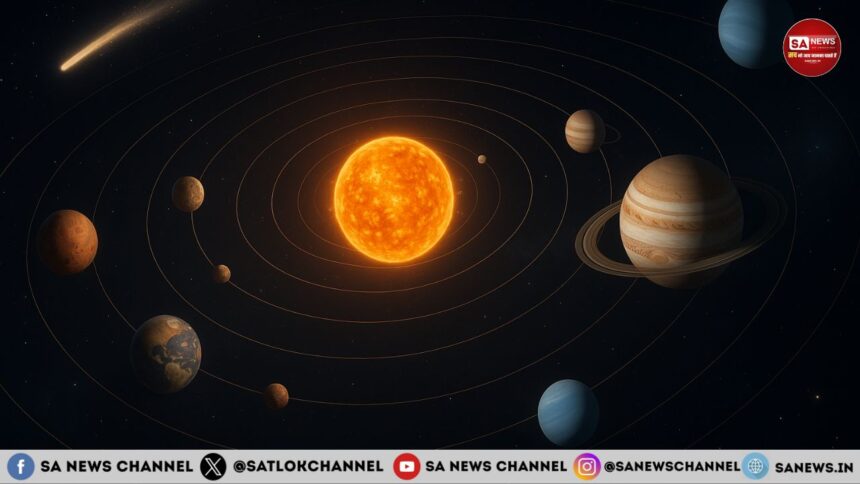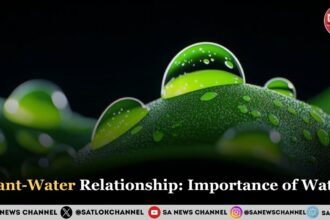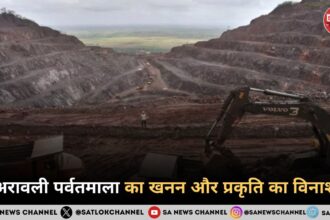Imagine a grand celestial event happening in the vast expanse of space, with the Sun as the glowing conductor at the center. This is our solar system—a wondrous arrangement of planets, moons, comets, and more, all held together by gravity and mystery. Understanding the solar system not only deepens our appreciation of the universe but also helps us explore our place within it.
The Structure of the Solar System
The Sun as the Center
The Sun is a giant ball of burning gases, primarily hydrogen and helium, that powers the solar system with its gravitational force and radiant energy. It’s the heart of our solar system and the reason why life exists on Earth.
Planets and Their Orbits
There are eight recognized planets, divided into:
- Terrestrial Planets (Mercury, Venus, Earth, Mars): Rocky and located closer to the Sun.
- Jovian Planets (Jupiter, Saturn, Uranus, Neptune): Huge, made mostly of gases, and found in the outer regions.
Moons
Moons orbit planets and vary in size and number. Earth has one; Jupiter has over 90, including Io, Europa, Ganymede (the largest), and Callisto—each with unique characteristics.
Other Celestial Bodies
- Dwarf Planets: Pluto, Eris, Haumea, Ceres.
- Asteroids: Small rocky bodies mostly in the asteroid belt.
- Comets: Icy travelers with glowing tails.
- Meteoroids: Space rocks that may become meteors or meteorites.
The Planets of the Solar System
Mercury
– Mercury, the closest planet to the Sun, has extreme temperatures, reaching 800°F (430°C) during the day and dropping to -290°F (-180°C) at night due to its elliptical orbit and lack of atmosphere.
– It has a 3:2 spin-orbit resonance, resulting in three rotations for every two orbits, making a solar day on Mercury last 176 Earth days.
– Key geological features include the large Caloris Basin from a major impact and thrust faults indicating the planet is shrinking as its core cools.
– Mercury’s poles have water ice hidden in shadowy craters.
– The planet has a weak magnetic field, about 1% of Earth’s, suggesting a partially liquid core, and its thin exosphere contains oxygen, sodium, hydrogen, helium, and potassium.
Venus
– Venus is called Earth’s twin due to its similar size and composition, but it has extreme conditions.
– Its thick atmosphere, rich in carbon dioxide and sulfuric acid clouds, creates a strong greenhouse effect, raising surface temperatures to about 900°F (475°C), hot enough to melt lead.
– Venus rotates in the opposite direction of most planets and takes 243 Earth days for one rotation, longer than its 225-day orbit around the Sun.
– This means a day on Venus is longer than a year.
– The planet features vast volcanic plains and has the most volcanoes in the solar system, making it important for studying climate change and planetary evolution.
Earth
– Earth is the third planet from the Sun and the only known place in the universe that supports life. It has a diameter of around 12,742 kilometers (7,918 miles) and weighs about 5.97 × 10²⁴ kilograms.
– About 71% of the planet’s surface is covered by water, with oceans containing roughly 97% of all water on Earth.
– The atmosphere is primarily made up of nitrogen (78%) and oxygen (21%), which helps sustain various ecosystems. Earth’s magnetic field, created by its molten iron core, protects it from solar winds and cosmic radiation.
– A full day on Earth lasts 24 hours due to its rotation, while it takes about 365.25 days to orbit the Sun, covering a distance of approximately 940 million kilometers (584 million miles). The planet’s tilt of 23.5 degrees results in different seasons.
– The Earth’s crust consists of tectonic plates that shift and alter the landscape, leading to mountains, earthquakes, and volcanic eruptions. The Himalayas are the highest mountain range, and the Pacific Ocean is the largest ocean. With over 8 billion people, Earth boasts a rich biodiversity and a vibrant mix of natural and cultural elements.
Mars
– Mars, often called the “Red Planet,” is the fourth planet from the Sun, characterized by its reddish appearance caused by iron oxide on its surface.
– It has a thin atmosphere rich in carbon dioxide and experiences extremely cold temperatures, averaging around -80°F (-60°C).
– Mars is roughly half the size of Earth, with a diameter measuring 6,779 kilometers (4,212 miles).
– The planet features the tallest volcano in the solar system, Olympus Mons, which stands at 21.9 kilometers, and the longest canyon, Valles Marineris, extending over 4,000 kilometers.
– Signs of ancient riverbeds suggest that Mars may have had a wetter and warmer climate in the past, raising questions about its ability to support life, while missions like Perseverance search for evidence of past life and prepare for human exploration.
Jupiter
– Jupiter is the largest planet in our solar system, with a diameter of 139,820 kilometers (86,881 miles). It is a gas giant primarily composed of hydrogen and helium, featuring stormy clouds and the Great Red Spot.
– It has a magnetic field 20,000 times stronger than Earth’s and generates more energy than it receives from the Sun. Jupiter has the shortest day of any planet, rotating in just 10 hours, while it takes nearly 12 Earth years to orbit the Sun.
– The planet has at least 95 moons, with the largest four being Io, Europa, Ganymede, and Callisto, discovered by Galileo in 1610. Ganymede is the largest moon in the solar system, and Europa may have an ocean beneath its icy surface that could support life.
– Jupiter’s massive size and unique features are crucial for understanding planet formation and the potential for life beyond Earth.
– As a true giant in the universe, Jupiter continues to fascinate scientists and astronomers.
Saturn
– Saturn, the sixth planet from the Sun, is famous for its beautiful rings made of ice and rock. It has a diameter of 120,536 kilometers (74,898 miles) and is the second-largest planet, mainly made of hydrogen and helium.
– A day on Saturn is about 10.7 hours long due to its fast rotation, and it takes around 29.5 Earth years to complete an orbit around the Sun. Its low density means it could float in water.
– Saturn has at least 146 moons, with Titan being the largest, even larger than Mercury. Titan has a thick atmosphere and methane lakes, making it significant for astrobiology. Enceladus has icy geysers that suggest a subsurface ocean.
– Saturn’s magnetic field is weaker than Jupiter’s but still significant. Its stunning rings and varied moons make it a fascinating planet in the solar system.
Uranus
– Uranus, the seventh planet from the Sun, has a unique sideways rotation with a 98-degree axial tilt, resulting in extreme seasons lasting about 21 Earth years.
– It has a diameter of 50,724 kilometers (31,518 miles) and is mainly composed of hydrogen, helium, and methane, giving it a light blue hue.
– As an ice giant, Uranus contains water, ammonia, and methane ices in its atmosphere and interior, taking 84 Earth years to orbit the Sun, with a day lasting around 17 hours.
– The planet has 27 known moons, the largest being Titania, and features faint rings made of ice and dust.
– Despite its calm appearance, Uranus experiences strong winds reaching speeds of up to 900 kilometers per hour, making it one of the most intriguing planets in the solar system.
Neptune
– Neptune is the eighth and farthest planet from the Sun, known for its deep blue color from methane in its atmosphere. It has a diameter of 49,244 kilometers (30,598 miles) and takes 165 Earth years to complete an orbit, making it the slowest planet. A day lasts about 16 hours.
– It has the strongest winds in the solar system, reaching speeds of 2,100 kilometers per hour (1,300 miles per hour). Its atmosphere mainly consists of hydrogen, helium, and methane, while the core contains water, ammonia, and methane ice.
– Neptune has 14 moons, with Triton being the largest. Triton is unique because it orbits in the opposite direction of Neptune’s rotation, suggesting it may have been captured by the planet.
– The planet features faint rings made of dust and ice particles, adding to its unique characteristics.
– Despite being over 4.3 billion kilometers (2.7 billion miles) from the Sun, Neptune’s dynamic storms and intriguing features make it an interesting subject for scientific research.
Beyond the Planets in Solar System
Asteroid Belt
– The asteroid belt is situated between Mars and Jupiter, filled with a variety of rocky and metallic objects called asteroids, which can be as small as dust or as large as dwarf planets.
– The combined mass of all the asteroids is significantly less than that of the Moon.
– This region hosts millions of asteroids, with Ceres being the largest at approximately 940 kilometers (584 miles) in diameter.
– Other significant asteroids include Vesta, Pallas, and Hygiea, which are leftovers from the early solar system that couldn’t form into a planet due to Jupiter’s gravitational pull.
– The asteroid belt is of great scientific interest, providing valuable information about how planets form and the solar system’s history. What interests you more about this area: its fascinating past or its exploration possibilities?
Comets
– Comets are icy space objects with elongated orbits around the Sun, often called “dirty snowballs” due to their composition of ice, dust, and rock.
– As they approach the Sun, heat turns their ice into gas, forming a bright coma and a tail that always points away from the Sun because of solar wind.
– Halley’s Comet is the most famous, appearing roughly every 76 years, and comets are categorized as long-period or short-period based on their orbital duration.
– Short-period comets, like those from the Kuiper Belt, orbit in under 200 years, while long-period comets from the Oort Cloud can take thousands of years.
– Comets are ancient remnants from the early solar system, offering insights into its formation and captivating people for centuries as signs or wonders from the cosmos.
Meteoroids, Meteors, and Meteorites
Here’s a clear overview of these intriguing space travelers:
– Meteoroids: These are small rocky or metallic pieces traveling through space, varying in size from tiny dust particles to larger asteroids. They often originate from comets, asteroids, or collisions in space.
– Meteors: When meteoroids enter the Earth’s atmosphere, they heat up from friction with air, resulting in a bright light display known as a meteor or “shooting star.” Most of these burn up completely before they can reach the ground.
– Meteorites: If a meteoroid makes it through the atmosphere and lands on Earth, it is referred to as a meteorite. These objects are important for scientific research, offering insights into the makeup of other celestial bodies and the early solar system.
The Sun: The Solar System’s Powerhouse
– The Sun is a G-type main-sequence star and is the dominant force in our solar system, making up more than 99.8% of its total mass.
– This massive ball of hot plasma produces energy through nuclear fusion, turning hydrogen into helium in its core.
– This energy release generates significant light and heat, which supports life on Earth and influences the entire solar system’s structure.
– The Sun’s gravity keeps all planets, asteroids, and comets in their orbits, while its activity, such as sunspots and solar flares, can affect space weather and disrupt technology on Earth.
– The solar wind, a flow of charged particles, creates the heliosphere, a protective bubble that extends well beyond Pluto, making it essential to study the Sun to understand its impact on technology and stellar processes.
Space Exploration and the Solar System
Historic Missions
- Voyager 1 & 2: Carried messages beyond the solar system
- Apollo missions: Landed humans on the Moon
- Mars Rovers: Like Perseverance and Curiosity
Future Goals
- Human missions to Mars
- Exploration of Europa and Titan
- Asteroid mining concepts
Technological Advances
Modern telescopes, satellites, and probes continue to provide astonishing insights into the solar system’s secrets.
Amazing Facts About the Solar System
- A day on Venus is longer than its year.
- Jupiter’s magnetic field is 20,000 times stronger than Earth’s.
- Neptune has winds up to 2,100 km/h.
- The dwarf planet Ceres might contain frozen water beneath its surface.
India’s Contributions to Space Exploration
India has made remarkable progress in space research, becoming a major player in inter planetary exploration:
- Chandrayaan-1 (2008): India’s first lunar mission, which discovered water molecules on the Moon—an achievement that changed how scientists understand lunar geology.
- Mars Orbiter Mission – Mangalyaan (2013): India became the first country to reach Mars on its maiden attempt, showcasing innovation and cost-efficiency.
- Chandrayaan-2 (2019): Though the lander faced challenges, the orbiter continues to gather valuable data about the Moon’s surface and exosphere.
- Chandrayaan-3 (2023): Achieved a successful soft landing on the Moon, marking a major milestone in India’s lunar exploration efforts.
- Aditya-L1 (2023): India’s first solar mission, launched to study the Sun’s corona and solar winds from Lagrange Point L1.
Future Indian Missions
India continues to aim high with ambitious space goals:
- Gaganyaan: India’s first human spaceflight program, aiming to send astronauts into low-Earth orbit.
- Shukrayaan: A proposed Venus mission designed to study the planet’s atmosphere and surface.
These efforts highlight India’s growing leadership in the global space community
Conclusion
The solar system is a remarkable realm of diversity, beauty, and scientific wonder. From blazing planets and frozen moons to the mysteries of deep space, it offers endless possibilities for discovery. As we continue to explore, may our curiosity keep growing—because every mission brings us closer to understanding the universe we call home.
A Spiritual Perspective: Sant Rampal Ji Maharaj’s Wisdom on the Solar System
Science helps us comprehend the physical world, while spiritual insight provides a deeper significance to our lives. Sant Rampal Ji Maharaj believes that the marvels of the solar system are not mere random occurrences but are part of a divine design overseen by a higher power—God Kabir. He illustrates this through sacred texts like the Bhagavad Gita and Sukshma Veda, stating that the creator of all celestial bodies is one Supreme God, who exists beyond time and space.
According to Sant Rampal Ji, while exploring space is important, understanding the purpose of human life is even more crucial. He teaches that we are not merely physical entities in a vast cosmos, but souls on a spiritual journey. The celestial bodies are part of a temporary creation, whereas the true home of the soul is in the eternal realm known as Satlok, which lies beyond the farthest reaches of the universe.
This harmonious perspective—combining scientific exploration with spiritual understanding—reminds us that as we admire the solar system, we should also pursue true knowledge (Tatvgyan) to achieve peace, liberation, and a connection with the Supreme Power.
FAQs: Exploring More About the Solar System
1. What are the inner and outer planets of the solar system?
The inner planets (Mercury, Venus, Earth, and Mars) are rocky and located close to the Sun. The outer planets (Jupiter, Saturn, Uranus, and Neptune) are gas or ice giants found farther away, with massive sizes and multiple moons.
2. Can humans live on any other planet in the solar system?
Currently, no other planet in the solar system has conditions suitable for human life. However, Mars is being studied for future human missions due to its similarities with Earth and potential for creating a habitable environment.
3. What is the Kuiper Belt and how is it related to the solar system?
The Kuiper Belt is a region beyond Neptune filled with icy bodies, dwarf planets like Pluto, and comets. It marks the outer edge of the solar system and helps scientists understand its formation and evolution.
4. How does the solar system reflect spiritual knowledge?
Sant Rampal Ji Maharaj teaches that the solar system is a divine creation by the Supreme God, and exploring it should inspire spiritual awakening. He emphasizes that understanding our soul’s journey beyond the material universe is the true purpose of life.









